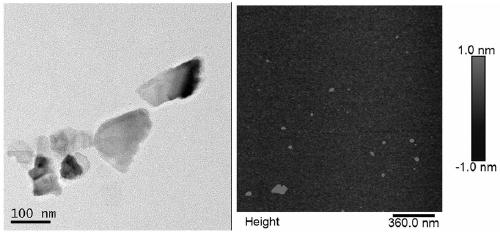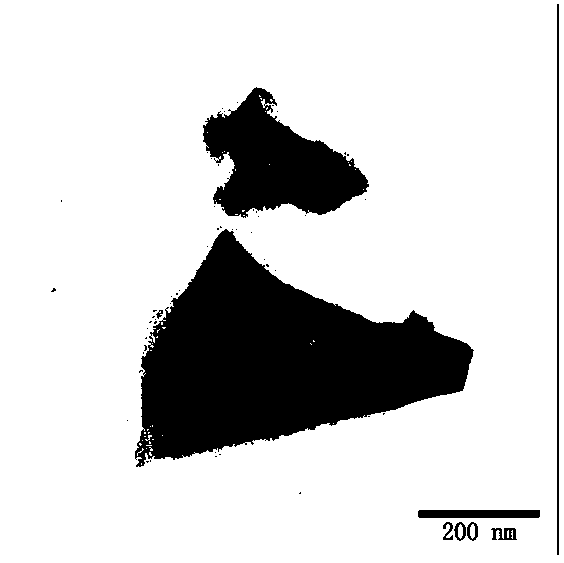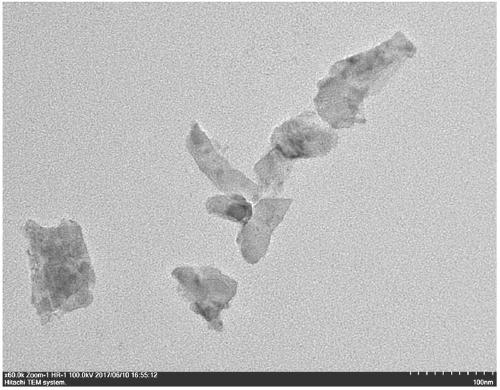A method for preparing two-dimensional nanomaterials using silk fibroin exfoliation
A technology of two-dimensional nanomaterials and silk fibroin, which is applied in the field of nanomaterial preparation and biomedical applications, can solve the time-consuming problems of two-dimensional nanomaterials, and achieve rapid and simple peeling preparation process, good biocompatibility, and good dispersion sexual effect
- Summary
- Abstract
- Description
- Claims
- Application Information
AI Technical Summary
Problems solved by technology
Method used
Image
Examples
Embodiment 1
[0016] Preparation of graphene nanomaterials using silk fibroin exfoliation
[0017] The silk was degummed, dissolved, dialyzed and filtered to prepare a silk fibroin aqueous solution with a mass concentration of 5%; the silk fibroin aqueous solution was reacted with a diazonium salt to modify the tyrosine residue of the silk fibroin by carboxylation. It is then reacted with chloroacetic acid to carboxylate the serine residue. After dialysis, a carboxylated silk fibroin solution with a mass concentration of 2% was prepared. Disperse 45g of graphite powder into 10ml of carboxylated silk fibroin solution, and then ultrasonicate for 2 hours at 300W ultrasonic power, then move the aqueous solution into a microtube and wash by centrifugation to obtain a monolayer of graphite dispersed in the aqueous solution. Two-dimensional nanomaterials. At the same time, the graphene two-dimensional nanomaterials were co-incubated with cells. After co-incubating with cells at high graphene con...
Embodiment 2
[0019] Preparation of black phosphorus nanomaterials using silk fibroin exfoliation
[0020] The silk was degummed, dissolved, dialyzed and filtered to prepare a silk fibroin aqueous solution with a mass concentration of 16%; the silk fibroin aqueous solution was reacted with a diazonium salt to modify the tyrosine residue of the silk fibroin by carboxylation. It is then reacted with chloroacetic acid to carboxylate the serine residue. After dialysis, a carboxylated silk fibroin solution with a mass concentration of 8% was prepared. Disperse 10g of black phosphorus powder into 200ml of carboxylated silk fibroin solution, then ultrasonicate for 5 hours at 50W ultrasonic power, then move the aqueous solution into a microtube, and centrifuge and wash to obtain 5 layers of fibroin dispersed in the aqueous solution. Black phosphorus two-dimensional nanomaterials. At the same time, the black phosphorus two-dimensional nanomaterials were co-incubated with cells. After co-incubating...
Embodiment 3
[0022] Preparation of black phosphorus nanomaterials using silk fibroin exfoliation
[0023] The silk was degummed, dissolved, dialyzed and filtered to prepare a silk fibroin aqueous solution with a mass concentration of 20%; the silk fibroin aqueous solution was reacted with a diazonium salt to modify the tyrosine residue of the silk fibroin by carboxylation. It is then reacted with chloroacetic acid to carboxylate the serine residue. After dialysis, a carboxylated silk fibroin solution with a mass concentration of 15% was prepared. Disperse 80 g of black phosphorus powder into 800 ml of carboxylated silk fibroin solution, and then shake the solution for 1 hour at a power of 300 W, then move the aqueous solution into a microtube, and centrifuge and wash to obtain a monolayer dispersed in the aqueous solution. Black phosphorus two-dimensional nanomaterials. At the same time, the black phosphorus two-dimensional nanomaterials were co-incubated with cells. After co-incubating ...
PUM
 Login to View More
Login to View More Abstract
Description
Claims
Application Information
 Login to View More
Login to View More - R&D
- Intellectual Property
- Life Sciences
- Materials
- Tech Scout
- Unparalleled Data Quality
- Higher Quality Content
- 60% Fewer Hallucinations
Browse by: Latest US Patents, China's latest patents, Technical Efficacy Thesaurus, Application Domain, Technology Topic, Popular Technical Reports.
© 2025 PatSnap. All rights reserved.Legal|Privacy policy|Modern Slavery Act Transparency Statement|Sitemap|About US| Contact US: help@patsnap.com



